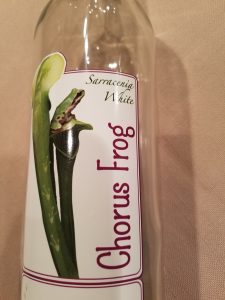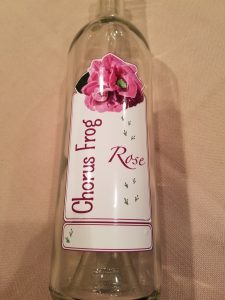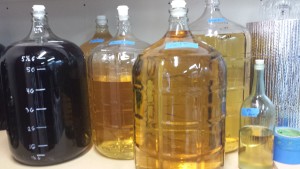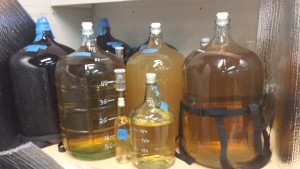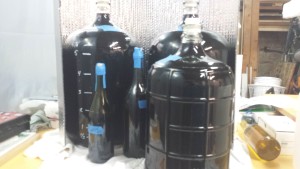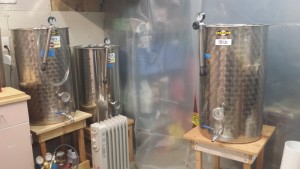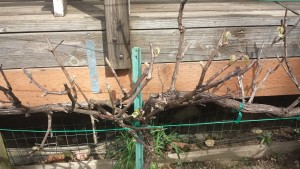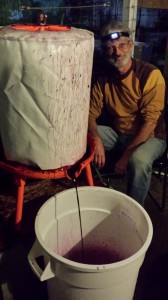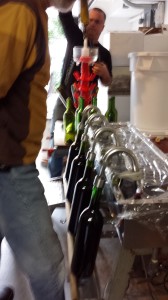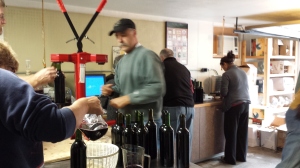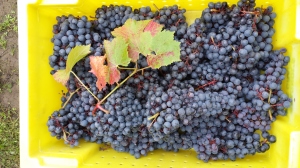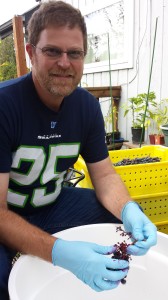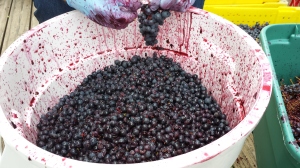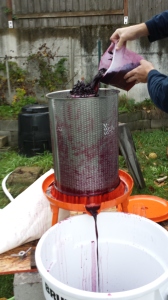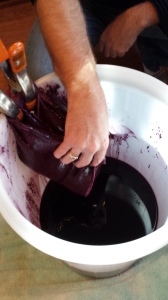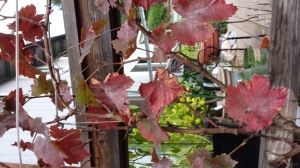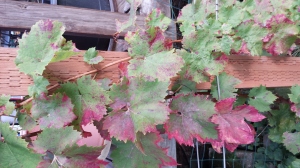Michael and Leann have decided to take the plunge and file as a commercial winery! The application has been submitted to the TTB. Hopefully 2019 will be our first commercial vintage and we’ll have some whites and rose available for sale in the spring of 2020!
2016 Bottled Up!
Hello everyone,
We’re trying to get back in the swing of things with posting more regular updates, but it seems to get away from me. Today we finished up bottling the 2016 reds. We bottled almost 12 cases (2 bottles short) of the second blend that’s been in our barrel. This one was 40% cab sauvignon, 40% merlot, and 20% malbec. The first blend that we bottled a couple of months ago was 40% malbec, 20% cab sauv, and 20% merlot. Both of them came out very tasty. While the volume of wine has been a lot this year, its nice to have the amount to let these age another year or 2 and see how they just keep getting better!
Michael is re-filling the barrel as I type with our 2017 reds. It will be a typical Washington Bordeaux Blend. This will be 33% malbec, 16% merlot, 16% cab franc, 16% petit verdot, and 16% syrah. No significant amount of cab sauv in this one – but Michael has 5 bottles of the 2016 cab that he is going to use for topping off, so that might equate to 1% cab. 🙂
We still have straight malbec, merlot, syrah, and cab franc in the tanks, plus a carboys of petit verdot and tempranillo. We likely won’t be bottling these until later in the summer before harvest and we need the space.
We also just got our new labels printed thanks to Lore (Leann’s sister)! She took pictures that Leann had taken of frogs on our plants and turned them into cool looking labels. She’s still working on our new red wine label – hopefully now that the frogs have come out we’ll get some better pictures for her to work with. Stay tuned.
Cheers! Leann & Michael
Bottling 2017 Whites
Hi everyone,
I know its been awhile since we posted any updates – but that doesn’t mean we haven’t been busy in the winery. Today we bottled the 2017 Pinot Gris, Gewurztraminer, and Rose of Cab Franc. We still have a lot of sauvignon blanc and viognier to bottle in the next couple of weeks. They’re all looking really pretty and are tasty!
We also bottled our first barrel blend a few months ago and it is very nice. The next blend that is currently in the barrel should be ready to bottle in another month or so – then its on to figuring out our next blend from the 2017s.
Will keep you posted – cheers!
Tasty whites
We’ve begun the bottling of our 2016 white wines. So far we have 2 cases of muscat, 4 pinot gris, 4.5 of viognier, and 4 of sangiovese rose bottled. Michael is still doing some adjustments with the sauvignon blanc, so we will likely bottle that the beginning of June. The chokecherry is coming along as well and we may bottle that in early June too. All are looking beautiful and tasting great so far. It should be a terrific summer of wine on the deck – if we can ever get to summer.
Finally getting to a new posting
I can’t believe how long it’s been since I last posted and much has been happening in the winery. The 2015 wines are tasty. We had a sauvignon blanc, pinot gris, rose, cab franc, malbec, merlot, petit verdot and cab sauv. The petit verdot was particularly surprising and good.
We had an interesting experience with our apricot wine. It seemed a little too tart so we added some simple syrup to sweeten it and lessen the acid. However even with filtering it restarted fermentation and we ended up with some popping corks. We unbottled everything, which was like pouring out shaken bottles of beer, and let it finish out fermentation again. For our wine club competition we entered 3 of the apricots of varying levels of sweetness; and the one that we didn’t add any extra sugar to won 1st place. The sauvignon blanc and cab sauvignon both came in second place.
Michael and Leann, along with friend and fellow winemaker Dawne started on a 3 year process for becoming certified wine judges through the American Wine Society. We also started a local chapter of the American Wine Society and have had a lot of fun with monthly meetings/tastings. Our group grows monthly, and anyone is welcome to join. In November 2016 we attended the AWS National Conference in Costa Mesa, CA. We had a great time at the conference and passed our 1st year exams for the judging program. Michael won a bronze metal for his malbec (50/50 2014/2015).
The 2016 wines are coming along nicely. For whites we have muscat, viognier, sauvignon blanc, and pinot gris. For reds: cab sauvignon, merlot, and malbec. We also are doing a sangiovese as both a rose and a full red as part of our wine club competition. We still have chokecherries in the freezer that need to get started on their wine journey soon.
Things are pretty quiet now with Michael just doing testing and racking. We should be ready for bottling the whites in April/May.
Hopefully it won’t take me another 18 months to do another post! Happy tasting! Leann
Bottling beginning!
The 2014 whites and rose are ready to be bottled and enjoyed for the summer. We have pinot gris, sauvignon blanc, and viognier. The rose of syrah ended up a little dark – like a light pinot noir, but still tasty. We’re bottling over memorial day weekend. And good news on the trouble child syrah – its turning out very nice!
Michael’s winemaking notes part 2 – my sweet, stuck syrah
April update….
In my last update, I was retesting the SG, pH, and TA of all my wines and making sure that all of my equipment was truly clean for the season. Well I found out that my syrah had not finished with the primary fermentation; it was “stuck”. I have syrah in three different containers, the specific gravity (SG) readings were, Tank #1 1.010, Tank #2 1.001 and #3 1.006. This is a big spread from the same batch of grapes.
So why was the syrah stuck? I think the main reasons are that the brix were too high, at about 27. I should have watered the wine down to 24. In addition, I was out of town and was not monitoring and feeding the yeast, as I should have been. I quickly made a few calls to confirm what my next step should be, and all agreed that I needed to do a restart. I have never done a restart before so I went to Winemaker Magazine.com and to Scott Labs.com to find the best procedure. Scott Labs had a good print out for the step-by-step procedure. Both web sites said the same thing but Scott Labs was easier to follow.
I will just give a quick overview of what I did. I am not giving amounts, because they are based on volume of the wine. So my numbers are based on my volumes. First, I added yeast hulls to help remove toxins from the wine 24 to 48 hours before the restart. When yeast struggles to finish due to bad conditions, they produce unwanted compounds in the wine. After the 48 hours I racked it off the lees. Next, add half as much yeast hulls and start hydrating the yeast. The recommended strain for this is Uvaferm 43. This is where you need to read the steps carefully because this yeast is going into a low sugar, high alcohol environment and you do not want to overfeed the yeast. The next step is a slow process designed to prevent the yeast from going into shock in this high alcohol low sugar environment.. I mixed a small amount of wine into the yeast and waited 20 min. Then I added 5% of the wine volume and an equal volume of water into the restart bucket and added yeast starter. Wait 30 min add 10% of wine volume, wait 30 min add 20%, and wait 30 min repeat this until all the wine is in the new fermenter. The wine should be warm, about 70° F or more; the range for this yeast is 56-95°F.
I had no clue how long this was going to take or how long it should take. There is no big foaming head, just a few small bubbles each day. However, this is how it went for me and the temperature was about 65-75°F. Make sure to correct for temperature with the hydrometer. Warmer wine is less dense than cold wine and most hydrometers are calibrated to 60° F.
#1 start 1.010, 1 wk,1.008, 2wk 1.007 3wk 1.005
#2 start 1.001, 1wk 0.999, 2wk 0.999, 3wk 0.999
#3 start 1.006, 1wk 1.004, 2wk 1.004, 3wk 1.001
Tank #2 got to dry”0.999″,but there is most likely still residual sugar in the wine, so I quickly put it back into the tank to protect from oxygen. But what to do about the other two batches of wine? Well, I was planning on making a Cab-Syrah-Merlot blend anyway so I thought, why not now? I had a small blending party to get some input on what percentages to do and this is what we came up with, tank #1 69% Syrah 15% Merlot and 16% Cab Sav. Batch #3 70% Syrah 13%Merlot 17% Cab Sav. Both the Syrah and Cab Sav are 2014 and the Merlot is from 2013. I blended the wines hoping that the blend would drop the SG some more and give it more acid, but wanted to wait a week to give it time to work things out while I was out of town. One week later, it was time to check on the wine and to my surprise, the two blended batches of wine were bubbling away. “It’s fermenting again!”
I had to wait a few more weeks for the bubbling to stop. I now have the results for tank #1 and batch #3. Tank #1 the SG is now 0.995 and a pH of 3.79. I am adding 50 ppm SO2 and adding tartaric acid in small doses until the pH and taste is where I want them. Batch #3 the SG is now 0.994 with a pH of 3.81, I will do the same as I did with tank #1 with the SO2 and acid.
I am not sure what the future will be for tank #2. I need to buy a clinitest to test how much residual sugar is still in the wine. I may bottle some of it as an almost off dry wine and save the rest for blending with next year’s grapes. If I do that, I will add it before new grapes are done fermenting so that any sugar in the syrah can be converted.
Michael’s winemaking notes part 1
What’s Been Going On In Michael’s Winery? (January update)
At the end of January I was doing some cleaning and rearranging in the winery to make the area more open when I found out that two of my primary fermenters had an odor. Over time one small spot of wine juice can spoil and lead to problems the next fall. Some dust and dirt will wash out easily but not moldy spots. So I cleaned all of my primaries with Oxyclean and StarSan again and made sure to check under the lip and all corners.
I inoculated my red wines with a malolactic bacteria back in October and have been testing the progress with a chromatography test kit from More Wine. The wine in the steel tanks is done with the malolactic fermentation (MLF) but the wine in the glass carboys is not. The wine that is finished with MLF was sulfited to 50 ppm and I added argon gas to stabilize the wine and will rack soon.
So why wasn’t the wine in the glass carboys done? Well, I had last year’s wine that needed to be bottled up on the countertop and the new wine on the floor. With the big cold snap the wine got cold due to the fact that I had not finished insulating the winery. The cold from the cement floor and the fact that cold air sinks were the difference. The wine was too cold to complete the MLF process like the tanks could. I now have two heaters in the winery and I finished insulating the walls.
Last year’s wine is now bottled and the new wine is up on the countertop where it is much warmer. Hopefully the new conditions will get the carboys to finish with MLF so I can start racking and sulfiting the wines and can get to other projects in the winery/shop this winter. I just retested the specific gravity (now that more solids have dropped out), pH, TA, to see if things have changed after MLF or for any other reason.
We’re still here!
Hi everyone,
its been a while since I posted, but that doesn’t mean we haven’t been busy with the winemaking. Michael’s been busy with testing and making sure the wines are behaving themselves. He’s had an interesting experience with the syrah this year, which we’ll post about separately.
Currently we’ve got some nice batches of pinot gris, viognier, sauvignon blanc, and plum going for whites. All but the plum should be ready to bottle and enjoy soon – just in time for nice weather! For reds we’ve got syrah, malbec, cab sav, and agria. Due to the issues with the syrah (to be discussed later), we ended up blending most of the syrah with merlot and cab sav. They’re turning out tasty, but likely will need another year to mature. FYI the funky foil bubble wrap is to keep the light off the glass carboys.
We were lucky to have 3 tanks on loan from friends. We will be buying one of them from our friend Dawne, who’s going more to barrels. Its our 10th wedding anniversay – and aluminum or tin are the traditional gifts – but we’re going to stretch it a bit. Of course the gift for 11 years is steel, so Michael will likely use that as an excuse to get another one.
Michael’s also been busy with organizing the shop to make it more winery friendly. The plastic sheeting is to keep it warmer through the winter.
The leaves are starting to come out on the vines, getting us thinking about grapes for next year!
More to come soon!
Leann
There’s light at the end of the tunnel, some space to walk in the winery, and good wine in process
Ask any winemaker how they’re doing this October and most will say crazy, busy, tired. With our hot, dry summer and terrific weather through September the grapes were just crazy and all were finishing quick and together. Michael’s been working out of town during the week so it’s made it even busier on the weekends trying to get everything done then. This is the time of year that reminds us why we don’t want to go commercial – and magnify this craziness 10 times. It has been a lot of fun and our friends have been really helpful coming over with little notice to help with crushing, pressing, sampling, and the not so much fun parts of winemaking lifting, cleaning, etc.
Last weekend was really busy. It started Friday with Michael and Dawne bottling several cases or our 2013 wines: merlot, cab franc, and malbec. He left several gallons of each for us to blend. Then Friday evening we pressed the syrah. This was an experience because it’s getting dark early now and makes for a challenge cleaning in the yard in the dark. Note to selves for next year – mount a flood light for the carport and yard. We had lots (about 9 gallons) of sludge left from the syrah pressing. And not wanting to let a few bottles get away, Michael decided to see if we could get some more out of it after it settled.
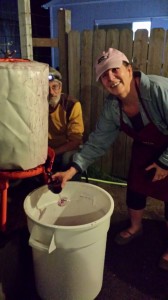 The following day we helped out our friends Dawne and Mark at her winery, Moose Canyon. She was bottling 27 cases of bordeaux blends from her barrels. She has a really cool/fun bottling machine that fills 4 bottles in 19 seconds. Much easier/quicker than the 45 seconds for 1 bottle with our siphon method. This was a great time with lots of friends, food, and wine. This was followed up by pressing at her house on Sunday.
The following day we helped out our friends Dawne and Mark at her winery, Moose Canyon. She was bottling 27 cases of bordeaux blends from her barrels. She has a really cool/fun bottling machine that fills 4 bottles in 19 seconds. Much easier/quicker than the 45 seconds for 1 bottle with our siphon method. This was a great time with lots of friends, food, and wine. This was followed up by pressing at her house on Sunday.
Sunday morning we went down and picked about 150 pounds of grapes in Puyallup. Sharon’s husband unexpectedly passed away earlier this year. He has 5+ types of grapes growing in his yard. Earlier this summer we bottled some of his wine that he had in process for the family. Michael is still working with his pear wine and we hope to get that bottled in the next week or so. The grapes we picked are similar to the agria that we are growing in our yard. We think they may be “Golubuk” based on the description in the nursery catalog. The name means “little pigeon” in Russian. It is also a tino or teinturier grape like our agria. That means that the juice is red as well as the skins. Most grapes have clear/light juice – and the color in the wine comes from the skins. We hand destemmed and crushed these grapes in the afternoon Sunday, while watching the Seahawks game (unfortunately they lost). This is quite a messy process because of the red juice. We added almost a gallon of agria grapes from our yard to this wine.
Today, Sunday 10/19 we pressed our Malbec. Then we strained the syrah “sludge”. We got an additional 4 gallons of non-sludge juice to add to the wine! Well worth the extra week and effort. That still left 4+ gallons of alcoholic sludge for the birds.
Since it was dry and sunny Leann spent some time cleaning up the gardens – getting rid of the dead squash vines and grape clusters. The leaves are getting gorgeous. These are our agria grapes.
So that leaves us down to just the cabernet sauvignon and the golubuk/agria still working on primary fermentation – and needing daily punch down. The rest are settling in nicely in their tanks or carboys going through malolactic fermentation. Our plan for next weekend is to press the cab and golubuk (will need to come up with a good name for this one). We’re also looking at playing with blending the 2013’s and bottling. Michael is also going to be adding oak to the reds next weekend.
I think that’s about it for the updates – so far. The wines are coming along great and should be tasty – in the next 1-2 years!
Everything should be settling down by the end of October. Take care everyone! Leann

